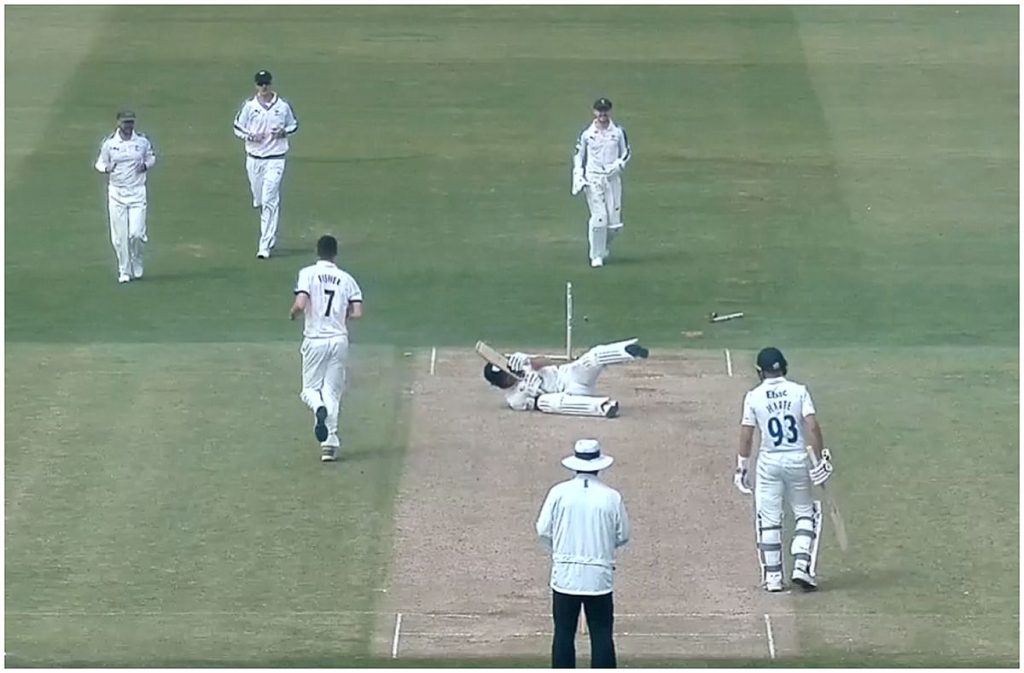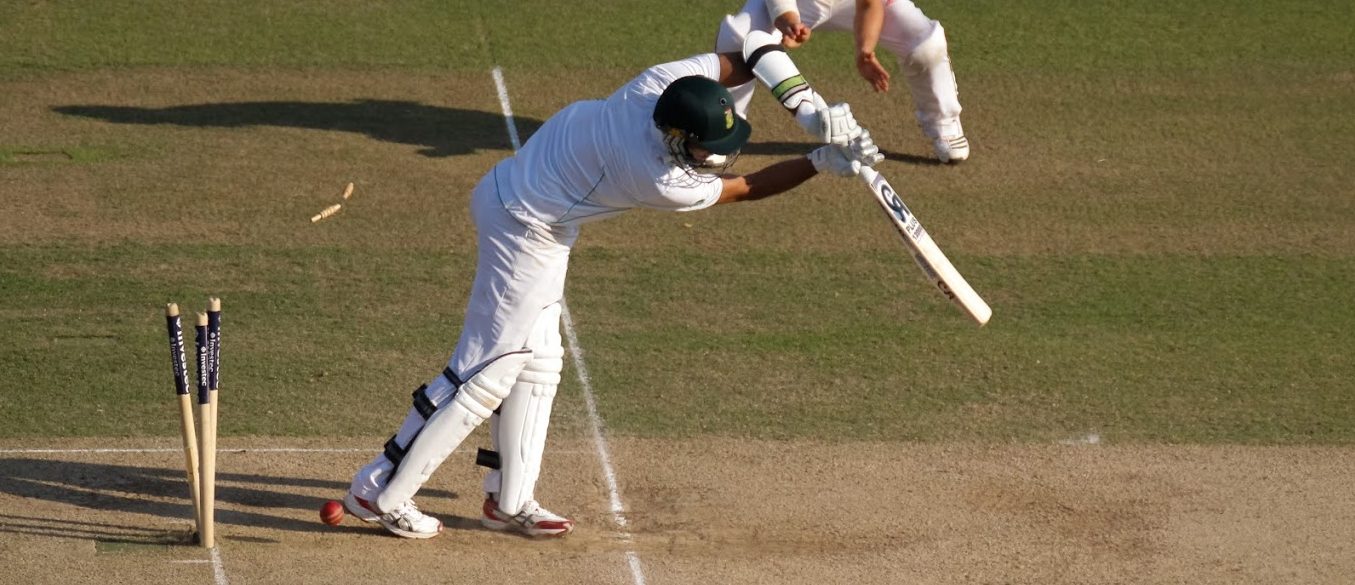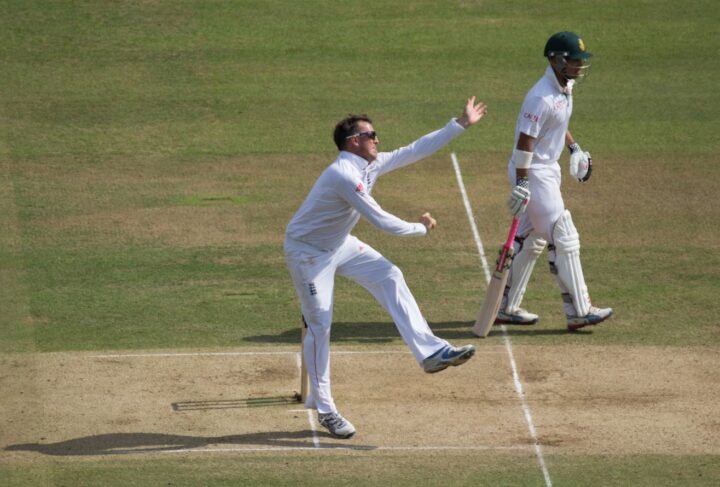So the sun is shining and all the windows are open. A game of cricket glows from the TV screen as I settle down with a cool beer. Oops, both openers have gone cheaply but we’ve still got the middle order; which slowly begins to crumble, and before you know it the all-rounder is about to be joined by the wicket-keeper.
The last two recognised batsman with 5 wickets down would soon expose the tail, a mythical beast that never seemed to wag properly – unless there was a batsman who could double up as wicket-keeper and allow for an extra batsman. Such luxuries were rare and if available never quite matched a specialist in that position.
The next wicket to fall would therefore introduce us to the lower order; a twilight world comprised of bowlers with ostensibly a simple brief; stay in, and if there is a recognised batsman at the other end, make sure he gets strike. But has the tail ender now become anachronistic in the modern game; and do we tacitly assume there is batting all the way down the order?
They had a transient, almost comical persona and secretly dreamed of declaration before the pads became necessary. One player immedietly springs to mind: Phil Tufnell, cricket’s equivalent to Gareth Southgate in a penalty shoot-out. A reluctant batsman and classic number 11 Tuffers was nicknamed The Cat, not for his lightening quick reflexes but fondness for sleeping.
Two Sugars also enjoyed a ciggie and so ideally suited to the more sedate art of spin bowling. His jovial manner actually concealed a very capable bowler who played in 42 tests over an eleven year period. However, a batting average of 5.10 is pretty sick even for a number 11. Of course it wasn’t his job to score runs but was there a pathological fear of taking the crease. Moreover, how much was cultivated to build the image of lovable underdog so cherished by the British public? His highest test score of 22 shows he could when the mood took him; were it not for that score his average would have been even lower.
As a batsman Devon Malcolm was fashioned from the same mould as Tuffers. One of the fastest bowlers to play for England, Malcolm had a chaotic and frantic style at the wicket. His batting average over 40 test appearances was only marginally better than Tuffers at 6.05. Perhaps surprising and a general point of curiosity was Malcolm’s inability to deal with fellow pace bowlers? Tuffers and Malcolm were typical tail enders but as always there are exceptions to the rule. The much missed Bob Willis had a highly credible batting average of 11.50; and depending on the brief could always be relied upon to merrily swing the bat. A short and explosive innings would often produce an entertaining boundary or two.
The late Graham Dilley was a particularly effective lower order batsman who scored two half centuries for England. This included a memorable 56 in a stand of 117 with Ian Botham in that Ashes match against Australia. Alex Tudor entered the history books in 1999 during the first test against New Zealand. Nasser Hussain was dismissed for 44 and Tudor elected nightwatchman at 174-3. Tudor went onto to score an unbeaten 99 in a 7 wicket victory. Graham Thorpe was rightly castigated for denying his Surrey teammate a richly deserved century.

However, the ultimate exceptions were the iconic West Indies test squad of the early 1980s. It contained lower order batsmen who were quasi all-rounders. Michael Holding scored six half centuries including an amazing 73 while Andy Roberts averaged almost 15 at test level. Malcolm Marshall scored ten half centuries and a monstrous 92. It was thought Joel Garner enjoyed batting more than bowling and recorded a top test score of 60. They seemed years ahead of their time; a uniquely talented group of players all of whom could bat and bowl. It was the template to which all sides aspired as bowlers were required to contribute more than just their specialised function.
At the turn of the 21st Century times were changing for the lower order. In July 2001, a stand of 103 for the 10th wicket was recorded by Alec Stewart and Andy Caddick in the first test against Australia. Number 11 Caddick scored an excellent 49 but couldn’t prevent an innings defeat for England. The feat has been achieved on eleven occasions since then, and is no longer a scarcity as sides lean on tail enders with greater confidence and guile.
Ashton Agar was a fresh faced all-rounder when selected by Australia for the first Ashes test at Trent Bridge in 2013. The nineteen-year-old was their youngest test player since 1928 and came in at number 11 with Australia floundering on 117-9. In partnership with Phil Hughes they compiled a then record 10th wicket stand of 163. Agar scored a magnificent 98 from 101 balls in the most impactful of debuts.
Amazingly, Agar and Hughes’ record only stood for a year. It was again at Trent Bridge that an England pair took over the mantle. Joe Root and Jimmy Anderson came together with England at 298-9, still 159 runs behind India’s first innings total of 457. A record breaking stand of 198 left Anderson on 81 and Root unbeaten on 154. A draw was salvaged and further proof served of how the lower order has changed over the years.
There now seems greater balance where the dividing line between specialist batsman and bowler is more flexible. Occasionally bowlers gain greater recognition as a batsman. The latest badge of distinction must surely belong to Somerset spinner Jack Leach who made his test debut against New Zealand in 2018.
However, Leachy’s finest hour came in the inaugural test against Ireland at Lords the following year. England was skittled out for 85 in their first innings, which felt a low score at T20 let alone a test match. Ireland held a lead of 122 as England commenced their second innings. Leach entered the fray as nightwatchman with England on 26-1. A tremendous knock of 92 eventually helped his team to a 143 run victory.
It may have only been test new boys Ireland but he saved England’s blushes when they were clearly in trouble. The supreme irony is that Leach only bowled three overs with figures of 0-26. For a specialist bowler his true value, at least on this occasion was as a batsman. He performed similar heroics in the third Ashes test and shared a partnership of 76 with Ben Stokes. He only contributed 1 run but helped secure victory by one wicket, and was described as arguably the greatest one not out in the history of the game. Leach is now a model tail ender; he covers the top order and keeps the innings alive when needed.
The bowling specialism has a curious function within the game’s tactical structure. If a frontline batsman can’t bowl it wouldn’t be an issue, if anything it would be viewed as a bonus if he could; however, a bowler inept with the bat would be looked upon as a luxury at best or a liability at worst. Just as well bowlers are more comfortable with the bat these days?
Brian Penn









Interestingly, when Dilley joined Kent, it was as a batsman. I seem to remember that for much of their partnership at Headingley he out scored Botham – I really loved his full swing of the bat ! A great, wholehearted cricketer who died tragically young.
That’s really interesting John. I didn’t know that. He was quite a stylish as a batsman I recall. I sometimes thought that a young Stuart Broad reminded me of him.
Monty Panesar was another great tail-ender. When it hit the middle of his bat, his cover drives were a thing of beauty. The problem, of course, is that it rarely hit the middle of his bat ;-)
James
I can certainly vouch for the accuracy of the story as he told it to me himself when I was fortunate enough to meet him ! I very much agree with you about the comparison with Broad, and indeed with your comments about Monty ! I think one of the (many) major changes during my cricket watching career has been the way lower order batsman have worked on their batting. It used to be the case that once you got six wickets, you were pretty much there, especially if you had a quickie or two to mop up the tail. Every now and then you got a plucky stand, especially if you still had an upper order batsman there, but that was a bonus. Now, with a few exceptions, lower order batsman don’t roll over without a fight.
Yep agreed.
Yeah, the late Graham Dilley looked good around number 8 in his early years as a test player. But his bowling started going wrong and he lost his place. When he came back he had transformed into a number 11 batsman. It seems he’d been happy to not work on his skills with the bat, depriving England of an all rounder.
He was followed by Gough and Broad. Two outstanding bowlers but I can’t help wondering how they’d have turned out if they’d have put a bit more work into their batting.
To be fair, Broad was shaping up well as a batsman until he took that hit to the head which destroyed his confidence.
I suppose the best ever number 11 (selected as such) might be Wilfred Rhodes, who gradually worked his way up the order to become a record breaking opener, with Jack Hobbs. Stuart Broad seems to be heading the other way.
I relished Peter Such, who was like Tuffers but without the talent, and Charl Willoughby was another to cherish. Batsmen are braver with helmets. I had a brief chat with former umpire Ray Julian one day (friend of a friend), and he said that when he faced Frank Tyson, his only ambition was to remain alive.
Good article. The comment on the 1980s West Indies side is well made. I recall that when Michael holding played Lancashire league cricket for Rishton CC in 1981, he took few wickets (balls would often bounce over the batsman’s head for multiple byes) but scored plenty of runs.
Where the point about the WI pacemen falls down is that it omits Colin Croft. Croft was a rank tailender with one shot, the block. He occasionally managed to stay in for some time (WI used him as nightwatchman) but he never made many runs. Croft was selected ahead of Sylvester Clarke who was a good enough tailender to win the Walter Lawrence Trophy for fastest century one season. Wayne Daniel was also no batsman. He got left out not because of his batting but because he got injuted too much. Holding and Roberts were both rank tailenders initially but improved their batting to become very useful, Garner more went the other way (like a Gough) and Marshall was always a near all-rounder who sometimes batted No.6 for Hampshire and made CC centuries.
One thing I’ve always thought an interesting split is between nightwatchmen who are rank tailenders and those who can bat a bit and might go on to a score the next day. I’ve always preferred the latter.
There are still some tailenders knocking around world cricket. Lyon and Hazlewood have played a lot of Tests between them without making a fifty. Gabriel can’t bat for toffee.
Gary Sobers batted at 9 on his Test debut. I’ve just checked out the scorecard and linked to it here because there are so many amazing names in those XIs. The batting lineups are astonishing! The Windies had the 3 Ws. And England’s top four was Hutton, Bailey, May and Compton! Poor Tom Graveney just about scraped into the side at 6. England’s attack wasn’t too shabby either. https://www.espncricinfo.com/series/england-tour-of-west-indies-1953-54-61754/west-indies-vs-england-5th-test-62772/full-scorecard
Personally I’ve never seen the excuse for a bowler not to be able to play at least a couple of shots reasonably well. It’s just laziness and the fact that the ‘Rabbit’ was classed as a figure of fun and something inevitable in a 10 or 11. Even in club cricket an 11 should be able to play a decent forward defensive and make a solid attempt to hit over cow corner, with a natural baseball swing. It is a team game after all.
Always remember Mike Hendrick being able to play a leg glance by lifting his back leg to make room for the often inside edge to fly past leg stump. It wasn’t exactly elegant but it proved effective enough for him to continue playing for years. Now there was a rabbit. As soon as he came to the wicket the opposition openers started limbering up. Allegedly he more than once forgot his bat, such a stranger it was to him.
Let’s not forget the worse tailender, possibly of all time – Chris Martin (NZ, 104 innings and a mighty 36 ducks!), with a brave and honest average of 2.3!
I was lucky enough to be in NZ in 2008, when Vaughan’s team won 2-1. At Napier, we watched Martin being given some of the easiest and slowest throw-downs you’ve ever seen, and he missed more than he hit. When he got out in the middle, Jimmy Anderson put one straight up his nose, first ball!
Martin survived that, and went on to make 5 of a last wicket partnership of 84. Tim Southee, on debut, made 77*.
I love this article! You took me right back to the glory days of my youth!
Peter R Drake
(retired teacher)
Hexham
Northumberland
Good information in this blog
#leadingcricket #cricketcoachingacademy
https://www.leadingcricket.com/
The bowling specialism has a curious function within the game’s tactical structure.
Good information
https://www.leadingcricket.com/
#leadingcricket #Cricketcoachinginbangalore
Great article!
My teacher used to say bowlers have to bat but batters don’t have to bowl so they are less important
Cricket lover
Hexham
Northumberland
“Peter Drake”
teacher playwright Hexham Northumberland
Yes – I totally agree. Broady and the Bobby Dazzler were/are always exposed for the rabbits they are. However, our skipper says that the mighty Bob Willis (RIP) was best described as a ferret, in that he went in after the rabbits
Peter Drake
Hexham